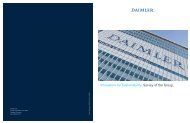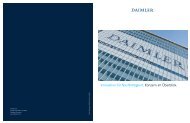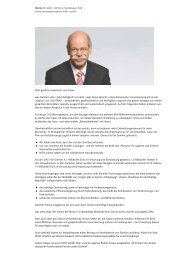Dear readers, This report describes what Daimler means by ...
Dear readers, This report describes what Daimler means by ...
Dear readers, This report describes what Daimler means by ...
Create successful ePaper yourself
Turn your PDF publications into a flip-book with our unique Google optimized e-Paper software.
<strong>Daimler</strong> 360 GRAD - FAKTEN zur Nachhaltigkeit 2008<br />
<strong>Daimler</strong> Nachhaltigkeitsbericht 2008 / Environmental protection, innovation, and safety / Innovation, development and safety / Fuels for the future<br />
<strong>Daimler</strong>’s fuel road map<br />
<strong>Daimler</strong>’s fuel road map<br />
1. Conventional fuels such as gasoline and diesel will continue to be used in the years ahead, which is why they<br />
must be continually optimized. The goal here is the worldwide use of sulfur-free fuel that contains low levels of<br />
aromatic compounds.<br />
2.<strong>Daimler</strong> believes that CNG (compressed natural gas) is a viable option for certain applications, because it<br />
contains less carbon than gasoline or diesel.<br />
3. Beside BTL (biomass-to-liquid) fuels, GTL (gas-to-liquid) fuels are the cleanest and highest-quality fuels for<br />
diesel engines. <strong>This</strong> is because GTL diesel is free of sulfur and aromatic compounds – although not CO 2 -neutral –<br />
and can be adapted to meet many of the requirements associated with internal combustion engines.<br />
4. Hydrogen will power the fuel cell vehicles of the future. In the fuel cell, the hydrogen reacts with oxygen to<br />
form water. Global hydrogen requirements have until now been largely met through steam reformation from<br />
natural gas. However, since this process still gives rise to CO 2 emissions due to the carbon content of the gas,<br />
suitable economically viable processes for H2 production from renewable sources must be developed.<br />
5. Bioethanol and biodiesel are intelligent options for the short to medium term when blended with conventional<br />
fossil fuels. However, such crop-derived fuels have a lower energy content, so their fuel economy is not as<br />
favorable as that of fossil fuels. In addition, the aggressiveness and viscosity of biodiesel, and a more<br />
pronounced clogging of the particulate filter, make its use in pure form prohibitive in modern diesel automobiles.<br />
6. BTL fuels made from biomass will soon grow in importance, initially as an admixture blended with gasoline and<br />
diesel fuel. The Group is currently working on ways to further the development and use of largely CO 2 -neutral<br />
synthetic biofuels. These fuels represent the optimal use of biomass, contain no sulfur or aromatic compounds,<br />
and their production does not compete with the cultivation of food crops. In addition, they can be excellently<br />
matched to the requirements of internal combustion engines.<br />
7. The fuel of the future is hydrogen from renewable sources, which in combination with the fuel cell will<br />
guarantee mobility free of emissions and CO 2 . Suitable production processes involve electrolysis using electricity<br />
derived from renewable sources (hydroelectric, wind, solar, and geothermic power) or from the gasification of<br />
biomass.














